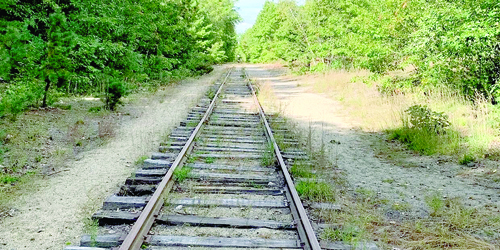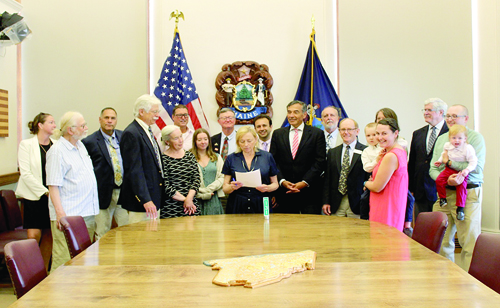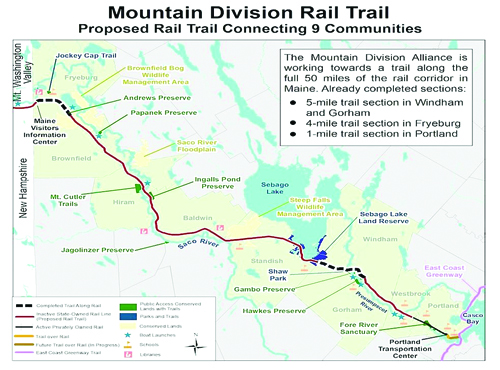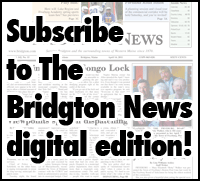Rails to Trails: Bill opens door to Mountain Trail Division expansion

By Wayne E. Rivet
Staff Writer
FRYEBURG — When Dave Kinsman first heard the goal of the Mountain Division Alliance to create a recreational trail connecting Portland to Fryeburg back in 1997, he was intrigued.
“The idea that I could ride off road to Portland, go to dinner, stay overnight, and ride the 52-mile trail back home really connected with me,” Kinsman said. “I have been involved with the MDA ever since.”
In 2003, Kinsman became MDA president and has been working to make the vision a reality ever since.
After decades of work, the Mountain Division Alliance landed a historic win last month when Maine Governor Janet Mills signed a bill sponsored by local State Senator Rick Bennett (LD 404) authorizing the Commissioner of Maine DOT to construct a multi-use “Trail Until Rail” from Standish to Fryeburg. This bill was passed by a large majority in the Maine Senate and House of Representatives.
Leading up to the drafting of LD404 was an extensive, seven-month review of potential rail and non-rail uses for the Mountain Division rail corridor from Standish to Fryeburg. The 12-member Mountain Division Rail Use Advisory Council (RUAC) voted 11 to 1 to recommend conversion of 31 miles of the existing railroad track to an interim 10-foot wide paved bicycle and pedestrian trail. The committee also recommended snowmobiles remain an allowable use, under annual agreement with MaineDOT, within the corridor.
Terry Egan of Brownfield said, “I volunteered to serve on the Mountain Division RUAC starting in 2021. I come from a family of rail and trail fans and have enjoyed traveling by railroad in various parts of the country and cycling. I fully intended to advocate for rail with trail in my role on the RUAC; however, after hearing presentations by experts on railroads and trails I was convinced to vote in favor the Trail until Rail alternative because it was the least expensive and will provide the most direct and lasting economic and health benefits for the residents of Brownfield and other towns on the rail corridor.”

The Mountain Division Trail will spur economic growth and connect Maine communities with a safe, car-free, multi-use trail. The Eastern Trail, arguably Maine’s most popular rail trail, has spurred millions of dollars of economic impact, according to this study. The rail trail will attract tourists, bolster local businesses, and provide a boost to the overall economy. The project will also create job opportunities, stimulate construction-related industries, and drive local investment, further strengthening the region's prosperity. Trails are a sound investment in Maine’s future in fact recent studies by American Trails have shown for every dollar spent on trails, there’s a three dollar return in the form of improved health.
Paul Schumacher, the president of Southern Maine Planning and Development Commission noted: “The passage of LD404 creates a pivotal moment and opportunity for the residents and towns along the western section of the Mountain Division Rail Corridor. The confluence of this opportunity with availability of grants and other funds brings the reality of accelerated economic development in the form of new businesses, real estate development, health benefits, and tourism within our reach.”

1958 — Passenger Service suspended
1983 — Freight Service stopped
1994 — Guilford Transportation announced that it was planning to abandon rail service on the Mountain Division Rail Line in Maine. Concerned that the rail right of way would be lost, Alix Hopkins, director of Portland Trails, brought people from over 20 groups together to form The Mountain Division Alliance. Out of this group came the vision for a rail with trail connecting the nine communities along the rail corridor. Those communities include: Portland, Westbrook, Windham, Gorham, Standish/Steep Falls, Baldwin, Hiram, Brownfield and Fryeburg.
1997 — Maine DOT purchased 40 miles of rail line from Route 202 in South Windham to the N.H. border in Fryeburg.
2003 — The first 5-mile section of trail opened from Gambo Road in Windham to Johnson Field in Standish. The trail initially had a gravel surface. The 1-mile section from Gambo to Route 202 was completed two years later. Alix Hopkins steps down as Director of MDA and Dave Kinsman became the MDA President after converting it to a 501c3 corp.
2004 — The Gambo Bike/Ped Bridge opened crossing the Presumpscot River forming a 1-mile loop connecting through Shaw Park in Gorham and reconnecting to the trail.
2006 — Portland Trails and Maine DOT opened a paved trail in Portland connecting Commercial Street with the Downeaster Transportation Center. The path follows the MD rail line from its beginning on Commercial Street completing the important first/last mile of the trail.
2007 — MaineDOT purchased the 5-mile section from Route 202 in South Windham to Westbrook. Before selling the section, Guilford removed the rails. New Fryeburg Visitor Center opens — future trailhead for MDT.
2009 — 5 miles of the Windham, Gorham, Standish MDT is paved. Usage greatly increases. Decision is made that all future sections of the MDT will have paving.
2010 — Fryeburg section receives funding for trail. This is due in part that Fryeburg is the second busiest entry into Maine and the new visitor center would provide necessary amenities to trail users.
2011 — Phase 1 of Fryeburg 1.5 mile trail section is completed from Maine Visitor Center on Route 302 to Porter Road.
2012 — Phase 2 competed in Fryeburg. 2.5 miles from Porter Road to Route 113 at the Brownfield line. Engineering completed on the 5-mile Windham/Westbrook section. Conway Rec Path Committee forms in North Conway area to work toward creating a bike/ped trail along the Mountain Division Rail Line from Bartlett through North Conway that would connect to the MDT in Fryeburg.
2013 — A meeting of officials and members from Windham, Westbrook, Sebago To The Sea and Mountain Division Alliance meet to discuss ways to raise matching funds for construction of a Windham-Westbrook section.
2016 — Sebago To The Sea Trail opens. Much of the western portion follows the Mountain Division Trail through Standish, Gorham and Windham.
2018 — Interest grows for constructing a section of the MDT next to the rail from the Transportation Center in Portland to Westbrook primarily because of the Rock Row development in Westbrook.
2020 — Mountain Division Alliance is prioritized in Maine Trails Coalition’s Rail Trail Vision Plan.
2021 — The Mountain Division Alliance is revitalized, updates their mission, and begins working on a strategic plan.
2021 — The Mountain Division Rail Use Advisory Council was officially formed in September of 2021 by Maine DOT Commissioner Bruce Van Note as a result of Resolve 21, Chapter 239.
2022 — MDOT awards a $350K grant to complete design and construction documents for the Mountain Division Westbrook to Windham section with contributions from those communities for a grant total of $450K.
2023 — Governor Janet Mills signs LD 404 into law, which authorizes the Maine DOT to construct a multi-use trail on the old Mountain Division Rail Line between Fryeburg and Standish. The bill was passed by a large majority in the Maine Senate and House of Representatives, demonstrating the legislature’s belief in the value of investing in trails for recreation and transportation. With the governor’s signature, an interim trail can now be built on 31 miles of unused rail corridor.
Trails connect towns, schools, jobs, and errands. Once completed, this Mountain Division Trail section in western Maine will be a continuous 40-mile, paved trail, running from Route 202 in South Windham to Fryeburg. Over time, it will connect with trails from Portland to North Conway, N.H.
Studies show for every $ 1 spent on trails, there is a $ 3 savings in healthcare costs. More overall physical activity is measured in communities after trails are built. Cardiovascular benefits are seen across all trail user types. This means healthier hearts, and a reduction in preventable disease for trail users and healthier people means a healthier economy. Other benefits include increased property values, improved connectivity, and equitable transportation options. Nothing is safer, cleaner, more affordable, or more accessible than a car-free trail for walking, biking, and commuting.
“The passage by both houses of the state legislature and the signing by the Governor of LD404 is the culmination of 30 years of work by many individuals, organizations, municipalities, and legislators in our quest to make the Mountain Division Trail a reality,” Kinsman said. “Work is now underway to complete the 5-mile section connecting South Windham to Westbrook and then it is on to Portland for the final phase of the 52-mile trail. Over time, it will connect with trails to the Mount Washington Valley. This was the original vision of the Mountain Division Alliance when it was founded in 1994. The Mountain Division Trail will be the best use of a much-underutilized public asset that has sat dormant for 40 years. It will bring joy and economic benefits to the towns of western Maine.”
Getting to this point, however, had its obstacles.
“It was hard for some people to finally realize that trains were never going to return to this part of western Maine. People are nostalgic when it comes to trains. They are big, they are cool, but it has been 60 years since passenger rail stopped and 40 years since there has been freight service,” Kinsman said. “It was decided by the legislature that the best use for this public asset is to convert it to a trail until times change and it might become necessary to convert it back to rail.”
Many of the long trails in this country are built on former railbeds.
“The concept of rail banking has been around for many years now. Rail banking has saved old rail beds from being sold off and broken up,” Kinsman noted. “They are there intact and available if they are needed for rail again. In the meantime, they are enjoyed by millions of people each year.”
Cycling has been a lifetime love and passion for Dave Kinsman.
“As a kid, my friends and I rode our bikes everywhere. We never thought about how far we were riding, but looking back it could be 50 miles a day. I lived on the outskirts of town and biking was the best way to get between the two towns I lived near. We tinkered on our bikes all the time. Bicycles offered us freedom and independence as kids,” he said. “Years later, I was between jobs and saw a sign on a bike shop that they were not taking in any repairs. I went in and started working as a bike mechanic. It was a learning experience for me, as well as the owner. I switched careers and went on to have several positions in the bike industry before opening my own bicycle import and distributing company, Downeast Bicycle. In all, I spent 25 years working in the bike industry.”
Kinsman says bicycles still give him a lot of joy.
“I get out on both my road and mountain bike several times a week and I still tinker with them,” he said.
As for what this major step forward to developing a connecting trail from Fryeburg to Portland means for cyclists, Kinsman said, “The Mountain Division Trail, when completed, will be one of the most widely used trails in New England. It will connect nine communities along the way; 51 miles, allowing people to commute and visit neighboring towns. Students can ride to schools in other towns. Trails create a sense of community. Importantly, the trail will provide a safe route for people of all ages to ride, walk, run or roller blade away from traffic.”
The two currently completed sections – 4 miles in Fryeburg and 5 miles in Windham and Gorham — each see over 100 users per day, Kinsman noted.
“Possibly the biggest impact the trail will have will be economic. Mount Washington Valley Trails Association has just opened a 3-mile bike/ped path and their goal is to connect to the MDT in Fryeburg,” he reported. “When we connect the city of Portland and the Mt. Washington Valley it will create a hugely popular 62-mile trail that will attract tourism from both directions. We have seen what these longer trails have done in other parts of the U.S. and Canada. Businesses start up. Bike shops, rental shops, coffee and ice cream shops, B&Bs and motels, restaurants and brewpubs all thrive on bike trails as people stop to eat, drink and stay.”
The trail Kinsman likes to compare to the MDT is in Quebec – Le P’tit Train Du Nord.
“This trail is also on an old rail bed and is 122 miles long. It winds through some of the same type of small towns that the MDT will. They have their own tourist center and run a shuttle service for people wanting to ride one-way or have their luggage moved from inn to inn. Just the number of people going through the tourist center totals 1,000,000 per year and generates $100,000,000 in economic activity,” he said. “Our towns in western Maine will benefit greatly in many ways when the Mountain Division Trail is completed.”

